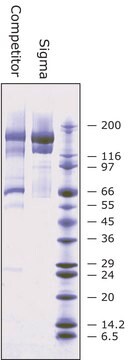M6514
3-(Trimethoxysilyl)propyl methacrylate
≥97%
Synonym(s):
Silane A174, [3-(Methacryloyloxy)propyl]trimethoxysilane
About This Item
Recommended Products
Quality Level
Assay
≥97%
form
liquid
refractive index
n20/D 1.431 (lit.)
bp
190 °C (lit.)
density
1.045 g/mL at 25 °C (lit.)
storage temp.
2-8°C
SMILES string
CO[Si](CCCOC(=O)C(C)=C)(OC)OC
InChI
1S/C10H20O5Si/c1-9(2)10(11)15-7-6-8-16(12-3,13-4)14-5/h1,6-8H2,2-5H3
InChI key
XDLMVUHYZWKMMD-UHFFFAOYSA-N
Looking for similar products? Visit Product Comparison Guide
General description
Application
- Isoelectric focusing can lead to pH gradient formation resulting in the swelling or shrinking of gel casts. This can be prevented by using 3-(Trimethoxysilyl)propyl methacrylate to link polyacrylamide gels to glass plates covalently.
- In situ hybridization using 3-(Trimethoxysilyl)propyl methacrylate along with poly-L-lysine is a faster and durable method to attach cells, microscopic sections, and total organs to slides/other glass surfaces.
- 3-(Trimethoxysilyl)propyl methacrylate is also used in the preparation of organic/inorganic hybrid nanomaterials.
Packaging
related product
Storage Class Code
10 - Combustible liquids
WGK
WGK 1
Flash Point(F)
197.6 °F - closed cup
Flash Point(C)
92 °C - closed cup
Personal Protective Equipment
Certificates of Analysis (COA)
Search for Certificates of Analysis (COA) by entering the products Lot/Batch Number. Lot and Batch Numbers can be found on a product’s label following the words ‘Lot’ or ‘Batch’.
Already Own This Product?
Find documentation for the products that you have recently purchased in the Document Library.
Customers Also Viewed
Our team of scientists has experience in all areas of research including Life Science, Material Science, Chemical Synthesis, Chromatography, Analytical and many others.
Contact Technical Service






![3-[Tris(trimethylsiloxy)silyl]propyl methacrylate contains MEHQ + HQ as stabilizer, 98%](/deepweb/assets/sigmaaldrich/product/structures/148/664/33ff5116-f264-4a64-824a-009c2ca5b2b3/640/33ff5116-f264-4a64-824a-009c2ca5b2b3.png)


